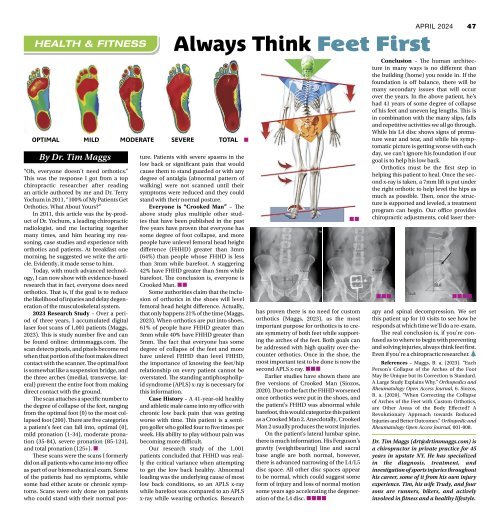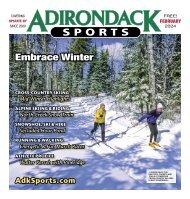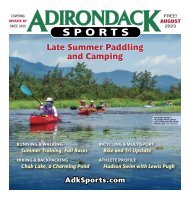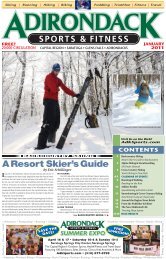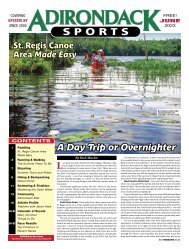Adirondack Sports April 2024
Create successful ePaper yourself
Turn your PDF publications into a flip-book with our unique Google optimized e-Paper software.
HEALTH & FITNESS<br />
OPTIMAL MILD MODERATE SEVERE TOTAL<br />
By Dr. Tim Maggs<br />
Always Think Feet First<br />
“Oh, everyone doesn’t need orthotics.”<br />
This was the response I got from a top<br />
chiropractic researcher after reading<br />
an article authored by me and Dr. Terry<br />
Yochum in 2011, “100% of My Patients Get<br />
Orthotics. What About Yours?”<br />
In 2011, this article was the by-product<br />
of Dr. Yochum, a leading chiropractic<br />
radiologist, and me lecturing together<br />
many times, and him hearing my reasoning,<br />
case studies and experience with<br />
orthotics and patients. At breakfast one<br />
morning, he suggested we write the article.<br />
Evidently, it made sense to him.<br />
Today, with much advanced technology,<br />
I can now show with evidence-based<br />
research that in fact, everyone does need<br />
orthotics. That is, if the goal is to reduce<br />
the likelihood of injuries and delay degeneration<br />
of the musculoskeletal system.<br />
2023 Research Study – Over a period<br />
of three years, I accumulated digital<br />
laser foot scans of 1,001 patients (Maggs,<br />
2023). This is study number five and can<br />
be found online: drtimmaggs.com. The<br />
scan detects pixels, and pixels become red<br />
when that portion of the foot makes direct<br />
contact with the scanner. The optimal foot<br />
is somewhat like a suspension bridge, and<br />
the three arches (medial, transverse, lateral)<br />
prevent the entire foot from making<br />
direct contact with the ground.<br />
The scan attaches a specific number to<br />
the degree of collapse of the feet, ranging<br />
from the optimal foot (0) to the most collapsed<br />
foot (200). There are five categories<br />
a patient’s feet can fall into, optimal (0),<br />
mild pronation (1-34), moderate pronation<br />
(35-84), severe pronation (85-124),<br />
and total pronation (125+). <br />
These scans were the scans I formerly<br />
did on all patients who came into my office<br />
as part of our biomechanical exam. Some<br />
of the patients had no symptoms, while<br />
some had either acute or chronic symptoms.<br />
Scans were only done on patients<br />
who could stand with their normal posture.<br />
Patients with severe spasms in the<br />
low back or significant pain that would<br />
cause them to stand guarded or with any<br />
degree of antalgia (abnormal pattern of<br />
walking) were not scanned until their<br />
symptoms were reduced and they could<br />
stand with their normal posture.<br />
Everyone is “Crooked Man” – The<br />
above study plus multiple other studies<br />
that have been published in the past<br />
five years have proven that everyone has<br />
some degree of foot collapse, and more<br />
people have unlevel femoral head height<br />
difference (FHHD) greater than 3mm<br />
(64%) than people whose FHHD is less<br />
than 3mm while barefoot. A staggering<br />
42% have FHHD greater than 5mm while<br />
barefoot. The conclusion is, everyone is<br />
Crooked Man. <br />
Some authorities claim that the inclusion<br />
of orthotics in the shoes will level<br />
femoral head height difference. Actually,<br />
that only happens 21% of the time (Maggs,<br />
2023). When orthotics are put into shoes,<br />
61% of people have FHHD greater than<br />
3mm while 40% have FHHD greater than<br />
5mm. The fact that everyone has some<br />
degree of collapse of the feet and more<br />
have unlevel FHHD than level FHHD,<br />
the importance of knowing the feet/hip<br />
relationship on every patient cannot be<br />
overstated. The standing antiphospholipid<br />
syndrome (APLS) x-ray is necessary for<br />
this information.<br />
Case History – A 41-year-old healthy<br />
and athletic male came into my office with<br />
chronic low back pain that was getting<br />
worse with time. This patient is a semipro<br />
golfer who golfed four to five times per<br />
week. His ability to play without pain was<br />
becoming more difficult.<br />
Our research study of the 1,001<br />
patients concluded that FHHD was really<br />
the critical variance when attempting<br />
to get the low back healthy. Abnormal<br />
loading was the underlying cause of most<br />
low back conditions, so an APLS x-ray<br />
while barefoot was compared to an APLS<br />
x-ray while wearing orthotics. Research<br />
<br />
<br />
has proven there is no need for custom<br />
orthotics (Maggs, 2023), as the most<br />
important purpose for orthotics is to create<br />
symmetry of both feet while supporting<br />
the arches of the feet. Both goals can<br />
be addressed with high quality over-thecounter<br />
orthotics. Once in the shoe, the<br />
most important test to be done is now the<br />
second APLS x-ray. <br />
Earlier studies have shown there are<br />
five versions of Crooked Man (Siozos,<br />
2020). Due to the fact the FHHD worsened<br />
once orthotics were put in the shoes, and<br />
the patient’s FHHD was abnormal while<br />
barefoot, this would categorize this patient<br />
as a Crooked Man 2. Anecdotally, Crooked<br />
Man 2 usually produces the worst injuries.<br />
On the patient’s lateral lumbar spine,<br />
there is much information. His Ferguson’s<br />
gravity (weightbearing) line and sacral<br />
base angle are both normal, however,<br />
there is advanced narrowing of the L4/L5<br />
disc space. All other disc spaces appear<br />
to be normal, which could suggest some<br />
form of injury and loss of normal motion<br />
some years ago accelerating the degeneration<br />
of the L4 disc. <br />
APRIL <strong>2024</strong> 47<br />
Conclusion – The human architecture<br />
in many ways is no different than<br />
the building (home) you reside in. If the<br />
foundation is off balance, there will be<br />
many secondary issues that will occur<br />
over the years. In the above patient, he’s<br />
had 41 years of some degree of collapse<br />
of his feet and uneven leg lengths. This is<br />
in combination with the many slips, falls<br />
and repetitive activities we all go through.<br />
While his L4 disc shows signs of premature<br />
wear and tear, and while his symptomatic<br />
picture is getting worse with each<br />
day, we can’t ignore his foundation if our<br />
goal is to help his low back.<br />
Orthotics must be the first step in<br />
helping this patient to heal. Once the second<br />
x-ray is taken, a 7mm lift is put under<br />
the right orthotic to help level the hips as<br />
much as possible. Then, once the structure<br />
is supported and leveled, a treatment<br />
program can begin. Our office provides<br />
chiropractic adjustments, cold laser ther-<br />
<br />
<br />
apy and spinal decompression. We set<br />
this patient up for 10 visits to see how he<br />
responds at which time we’ll do a re-exam.<br />
The real conclusion is, if you’re confused<br />
as to where to begin with preventing<br />
and solving injuries, always think feet first.<br />
Even if you’re a chiropractic researcher.<br />
References – Maggs, B. a. (2023). “Each<br />
Person’s Collapse of the Arches of the Foot<br />
May Be Unique but its Correction is Standard.<br />
A Large Study Explains Why.” Orthopedics and<br />
Rheumatology Open Access Journal, 6. Siozos,<br />
B. a. (2020). “When Correcting the Collapse<br />
of Arches of the Feet with Custom Orthotics,<br />
are Other Areas of the Body Effected? A<br />
Revolutionary Approach towards Reduced<br />
Injuries and Better Outcomes.” Orthopedic and<br />
Rheumatology Open Access Journal, 001-008.<br />
Dr. Tim Maggs (drt@drtimmaggs.com) is<br />
a chiropractor in private practice for 45<br />
years in upstate NY. He has specialized<br />
in the diagnosis, treatment, and<br />
investigation of sports injuries throughout<br />
his career, some of it from his own injury<br />
experience. Tim, his wife Trudy, and four<br />
sons are runners, bikers, and actively<br />
involved in fitness and a healthy lifestyle.


